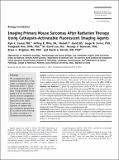Imaging Primary Mouse Sarcomas After Radiation Therapy Using Cathepsin-Activatable Fluorescent Imaging Agents
Author(s)
Cuneo, Kyle C.; Mito, Jeffrey K.; Javid, Melodi P.; Kim, Yongbaek; Lee, W. David; Brigman, Brian E.; Kirsch, David G.; Ferrer, Jorge M; Bawendi, Moungi G; ... Show more Show less
DownloadCuneo-2013-Imaging Primary Mous.pdf (969.2Kb)
PUBLISHER_CC
Publisher with Creative Commons License
Creative Commons Attribution
Terms of use
Metadata
Show full item recordAbstract
Purpose:
Cathepsin-activated fluorescent probes can detect tumors in mice and in canine patients. We previously showed that these probes can detect microscopic residual sarcoma in the tumor bed of mice during gross total resection. Many patients with soft tissue sarcoma (STS) and other tumors undergo radiation therapy (RT) before surgery. This study assesses the effect of RT on the ability of cathepsin-activated probes to differentiate between normal and cancerous tissue.
Methods and Materials:
A genetically engineered mouse model of STS was used to generate primary hind limb sarcomas that were treated with hypofractionated RT. Mice were injected intravenously with cathepsin-activated fluorescent probes, and various tissues, including the tumor, were imaged using a hand-held imaging device. Resected tumor and normal muscle samples were harvested to assess cathepsin expression by Western blot. Uptake of activated probe was analyzed by flow cytometry and confocal microscopy. Parallel in vitro studies using mouse sarcoma cells were performed.
Results:
RT of primary STS in mice and mouse sarcoma cell lines caused no change in probe activation or cathepsin protease expression. Increasing radiation dose resulted in an upward trend in probe activation. Flow cytometry and immunofluorescence showed that a substantial proportion of probe-labeled cells were CD11b-positive tumor-associated immune cells.
Conclusions:
In this primary murine model of STS, RT did not affect the ability of cathepsin-activated probes to differentiate between tumor and normal muscle. Cathepsin-activated probes labeled tumor cells and tumor-associated macrophages. Our results suggest that it would be feasible to include patients who have received preoperative RT in clinical studies evaluating cathepsin-activated imaging probes.
Date issued
2013-05Department
Massachusetts Institute of Technology. Department of Chemistry; Koch Institute for Integrative Cancer Research at MITJournal
International Journal of Radiation Oncology*Biology*Physics
Publisher
Elsevier B.V.
Citation
Cuneo, Kyle C., Jeffrey K. Mito, Melodi P. Javid, Jorge M. Ferrer, Yongbaek Kim, W. David Lee, Moungi G. Bawendi, Brian E. Brigman, and David G. Kirsch. “Imaging Primary Mouse Sarcomas After Radiation Therapy Using Cathepsin-Activatable Fluorescent Imaging Agents.” International Journal of Radiation Oncology*Biology*Physics 86, no. 1 (May 2013): 136–142.
Version: Final published version
ISSN
03603016